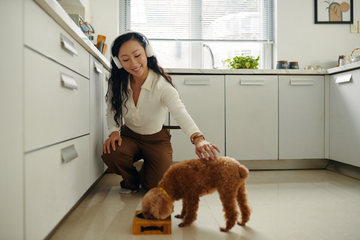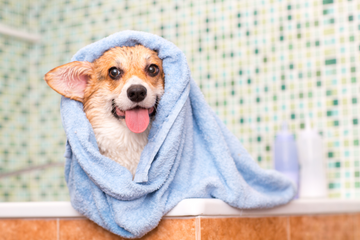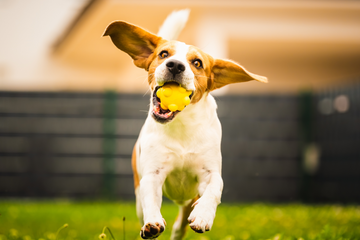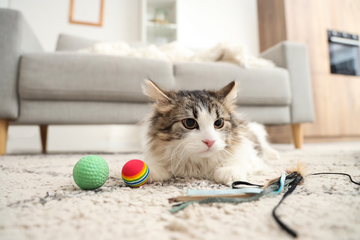Mealtime for pets might seem simple: fill the bowl, watch them eat, and move on. However, there are hidden challenges that many pet parents overlook. From overeating and fast eating to spilled water and messy feeding areas, these issues can affect your pet’s health, comfort, and overall wellbeing. Understanding these problems and taking practical steps to address them can make mealtime healthier, cleaner, and more enjoyable for both pets and their caregivers.
Fortunately, a combination of thoughtful routines and the right tools can solve most common mealtime problems, making daily feeding a smooth, stress-free experience.
The Dangers of Fast Eating
Many pets, particularly dogs, tend to eat too quickly. While it may seem harmless, eating too fast can lead to digestive issues, bloating, and discomfort. Pets that rush through meals may also be at risk of choking or vomiting.
The Anti-Slip Slow Feeder Puzzle is designed to encourage slower, more mindful eating. By turning mealtime into a game, pets take their time to retrieve food, reducing the risk of digestive problems and promoting healthier eating habits. Slow feeders also provide mental stimulation, keeping pets engaged while they eat.
Automatic Feeders for Busy Pet Parents
Busy schedules can make it difficult to maintain consistent feeding times. Irregular meals can cause stress and digestive disturbances for pets. Automatic feeders ensure your pet receives food at the right times, maintaining a stable routine.
The Automatic Pet Food Dispenser is an ideal solution for scheduled feeding. It dispenses precise portions at set times, helping manage weight and preventing overeating. Automatic feeders are particularly useful for multi-pet households, ensuring each animal receives the correct amount of food without conflict or stress.
Spilled Water and Hydration Challenges
Water is just as important as food, yet many pets struggle with spills or contamination. Messy water bowls not only create cleaning challenges but can also discourage pets from drinking enough. Dehydration can lead to health problems, including urinary issues, kidney stress, and lethargy.
A Non-Spill Drinking Water Bowl provides a practical solution. Its design minimizes splashing while keeping water accessible, clean, and fresh. Encouraging pets to drink consistently supports overall health and keeps your feeding area neat.
The Benefits of Elevated Feeding
The height of a pet’s feeding station can significantly impact their comfort and digestion. Eating from a bowl that is too low can strain a pet’s neck and joints, particularly in larger dogs or older pets.
The Elevated Double Feeder Bowl offers a more comfortable feeding position while accommodating both food and water. Elevated bowls promote better posture, reduce neck strain, and can aid digestion by allowing food to move more easily through the digestive tract.
Protect Your Floors and Keep Feeding Areas Clean
Feeding areas can get messy, especially with water spills and stray kibble. A clean and organized feeding station helps maintain hygiene and reduces the time spent cleaning after meals.
The Silicone Pet Double Bowl Mat is perfect for this purpose. It keeps bowls in place, catches spills, and provides a designated area for feeding. This mat protects floors from scratches, stains, and water damage while making cleanup effortless.
Combining Tools for a Better Mealtime Routine
Using the right combination of products can transform mealtime into a healthier and more enjoyable experience:
-
Slow feeders like the Anti-Slip Slow Feeder Puzzle encourage mindful eating and prevent digestive issues.
-
Automatic feeders ensure consistent meal timing, portion control, and convenience.
-
Non-spill water bowls maintain hydration while keeping feeding areas clean.
-
Elevated feeders promote comfort, better digestion, and joint-friendly posture.
-
Silicone mats protect floors and create an organized, hygienic feeding area.
By integrating these tools, pet parents can address most common mealtime challenges effectively. The combination of comfort, hygiene, and mental engagement ensures pets enjoy their meals while minimizing stress for caregivers.
Tips for a Stress-Free Feeding Routine
-
Maintain Consistent Feeding Times: Regular meals help regulate digestion and establish a predictable routine.
-
Rotate Toys and Puzzles: Some pets benefit from having meals inside interactive slow feeders occasionally to make eating fun and stimulating.
-
Monitor Portion Sizes: Use automatic feeders or measuring cups to prevent overeating and maintain a healthy weight.
-
Encourage Hydration: Place water bowls near food stations and use non-spill designs to ensure consistent access.
-
Keep the Area Clean: Use silicone mats or elevated stations to reduce mess, making cleanup quick and easy.
A structured routine, combined with the right feeding tools, prevents common problems and promotes a healthy, stress-free mealtime experience for pets.
Understanding the Long-Term Benefits
Addressing hidden mealtime problems has long-term benefits. Pets that eat slower, drink properly, and feed from comfortable positions are less likely to develop digestive issues, obesity, or joint strain. Additionally, reducing stress around mealtime creates a positive feeding environment, encouraging better behavior and stronger trust between pets and caregivers.
Consistently using products like the Anti-Slip Slow Feeder Puzzle, Automatic Pet Food Dispenser, Non-Spill Drinking Water Bowl, Elevated Double Feeder Bowl, and Silicone Pet Double Bowl Mat ensures that pets’ daily nutritional needs are met in a safe, enjoyable, and practical manner.
Final Thoughts
Mealtime is more than just feeding your pet — it’s an opportunity to support their health, comfort, and wellbeing. Many hidden challenges, such as fast eating, inconsistent feeding times, hydration issues, and messy feeding areas, can be solved with thoughtful routines and practical tools.
With a little planning and the right resources, every meal can become an opportunity to improve pets’ physical health, mental stimulation, and overall happiness — making mealtime better for both pets and their caregivers.











